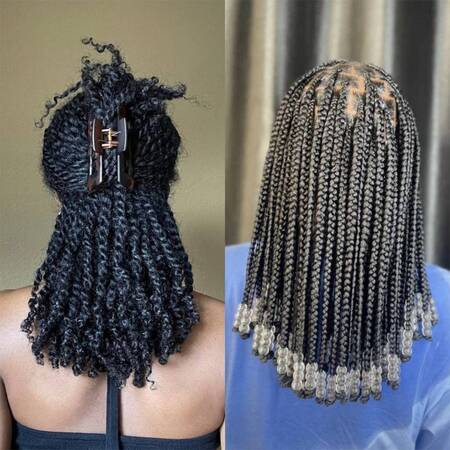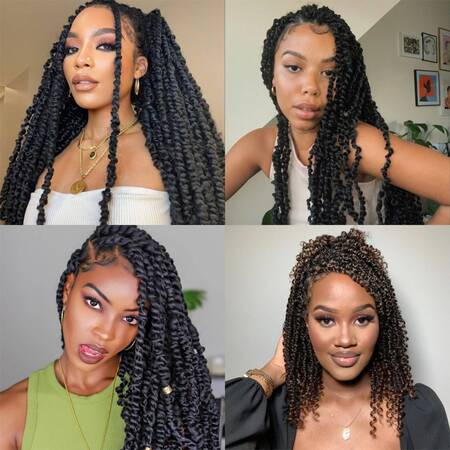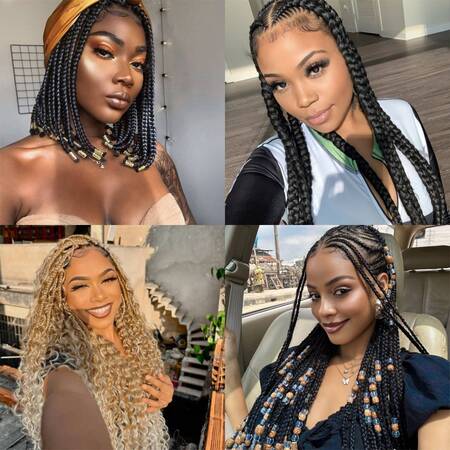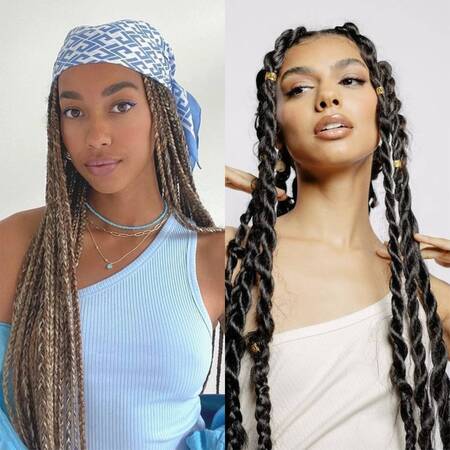
Twists vs Braids, What Works Best for You
Braids and twists are popular protective hairstyles among Black women, known for their variety and ability to support healthy hair development. Today, we'll look at the essential differences between braids and twists, including their processes, care requirements, and the distinct advantages each style provides. Understanding these variations might help you choose the ideal style for your needs, whether you're thinking about changing or are simply curious.

What Are Twists?
Twists are a protective hairstyle created by wrapping two strands of hair around each other. This simple yet effective technique gives your hair a coiled or rope-like appearance. To create twists, you divide your hair into sections, take two strands, and twist them together from root to tip. The process is straightforward and doesn’t require much time, making it a great option for those who want a quick yet stylish look. Each type of twist allows you to express your creativity while protecting your hair.

Here are some popular types:
Advantages of Twists Hairstyle
Twists is also a favorite of many people, it has the following advantages:
Quick installation: Compared to braids, twists take less time to install, making them a convenient choice for busy schedules.
Scalp-friendly: Twists apply less tension, reducing the risk of discomfort or damage to your scalp.
Versatility: You can style twists in various ways, from buns to ponytails, or even leave them loose for a carefree vibe.
Disadvantages of Twists Hairstyle
Frizz and Messiness: Twists can become frizzy and messy more quickly than other braid styles. This often requires extra effort to keep them looking neat, especially after a few weeks.
Less Longevity: Compared to braids, twists may not last as long without needing touch-ups or re-twisting, which can be a drawback for those looking for low-maintenance options.
Potential for Breakage: Similar to braids, if twists are too tight or left in for too long, they can also cause breakage and damage to the hair strands.
What Are Braids?
Braids are a timeless hairstyle made by weaving three or more strands of hair together. This technique creates elaborate designs that vary in size and style. Braided hairstyles can be created by equally sectioning your hair and crossing the strands over each other in a structured pattern. Braided hairstyles come in a variety of styles, each with its own unique appeal.

Here are some popular types:
Advantages of Braids Hairstyle
Braids offer several benefits that make them a go-to choice for many. Here’s why you might love them:
Long-lasting style: Braids, especially knotless braids, can last up to eight weeks with proper care. This makes them ideal if you want a low-maintenance option.
Protective benefits: Braided hairstyles shield your natural hair from daily wear and tear. They help retain moisture and reduce breakage.
Versatility: You can style braids in countless ways, from buns to ponytails. Knotless braids, in particular, give you a natural look that blends seamlessly with your hair.
Disadvantages of Braids Hairstyle
Tension and Breakage: Braids, especially if done too tightly, can create tension on the hair strands, leading to breakage and damage over time.
Scalp Irritation: This can be due to the pulling on the scalp or allergic reactions to chemicals in synthetic hair, resulting in symptoms like itching, soreness, or even blisters.
Time-Consuming: Installing and removing braids can be a lengthy process. Depending on the complexity of the style, it may require several hours in the salon, which can be inconvenient for those with busy schedules.
Key Differences Between Twists and Braids
To help you better understand the differences between twists and braids, we’ve provided a clear comparison table below. This table highlights the key distinctions. Following the table, you'll find a more detailed explanation of each aspect, allowing you to make an informed decision based on your preferences and lifestyle.
| Aspect | Twists | Braids |
| Technique | Two strands of hair are twisted around each other, forming a rope-like texture. | Three strands of hair are woven together, crossing over each other in a structured pattern. |
| Time to Create | Typically, faster to create than braids. | Takes longer, as it involves a more intricate process. |
| Texture & Look | Creates a smooth, spiral-like appearance. | Produces a more textured, interwoven look. |
| Durability | Less sturdy, and may unravel faster if not properly maintained. | More secure, and typically lasts longer than twists. |
| Maintenance | Easier to maintain, less likely to require frequent touch-ups. | Requires more upkeep and attention to avoid frizz or unraveling. |
Installation Time
When it comes to installation, twists take less time than braids. You can complete twists in just a few hours, depending on the size and length you choose. Braids, on the other hand, require weaving three or more strands of hair, making the process more intricate and time-consuming. If you’re short on time or prefer a faster styling option, twists might be the better choice for you.
Texture and Appearance
The texture and appearance of twists and braids differ significantly. Twists have a softer, more natural look that blends seamlessly with your hair. They create a coiled or rope-like texture, giving off a relaxed vibe. Braids, however, offer a more structured and polished appearance. Their woven pattern stands out, making them ideal for bold and intricate styles.
Longevity and Durability
Braids generally last longer than twists. Their tight weave makes them more durable and resistant to unraveling. With proper care, braids can stay intact for up to eight weeks. Twists, while beautiful, tend to have a shorter lifespan. They may start to loosen or frizz after a few weeks, especially if you have fine or silky hair. If you’re looking for a long-lasting style, braids are the better option.
Maintenance
Maintaining twists and braids requires different approaches, so understanding their care routines is essential. Twists are easier to maintain daily. Braids, on the other hand, demand a bit more effort. Their tight structure makes it harder for moisture to penetrate, so regular scalp care is crucial.
Braids VS Twists, Which One Is Best?
Both hairstyles have pros and cons, and you cannot blindly say that one is better than the other. It depends on the preferences of various people. For instance, some people prefer braid-outs over twist-outs, but some may prefer the twist-out style.

It can also depend on the type and texture of your hair as well. For example, if you are looking for a quick, low-tension style and you have more kinky, coily, type hair, then twists are perfect for you. Braids will be the right choice for you if you want a long-lasting, low-maintenance style and don’t mind spending a bit longer getting it done.
You can always try both hairstyles to see which one suits you best. No matter which style you choose, it will protect your hair from damage and promote hair growth.
FAQ
Which style looks more natural, braids or twists?
Twists tend to look more natural because they blend seamlessly with your hair. They create a soft, coiled texture that mimics the appearance of natural curls. Braids, on the other hand, offer a more structured and polished look.
Are twists or braids better for sensitive scalps?
Twists are better for sensitive scalps. They apply less tension during installation, reducing the risk of discomfort or damage. If you have a sensitive scalp, twists might be the more comfortable choice.
Can I style braids and twists in different ways?
Yes, both styles are versatile. You can wear braids in buns, ponytails, or intricate updos. Twists also offer styling options, such as loose styles, buns, or twist-outs. Both let you experiment with different looks.
Summary
Both twists vs braids offer incredible protective styling options, but the best choice depends on your needs. When deciding which one is better, think about your priorities. Do you value longevity, easy maintenance, or a specific appearance? Whether you choose knotless braids or twists, both styles let you express yourself while keeping your hair healthy and stylish.
